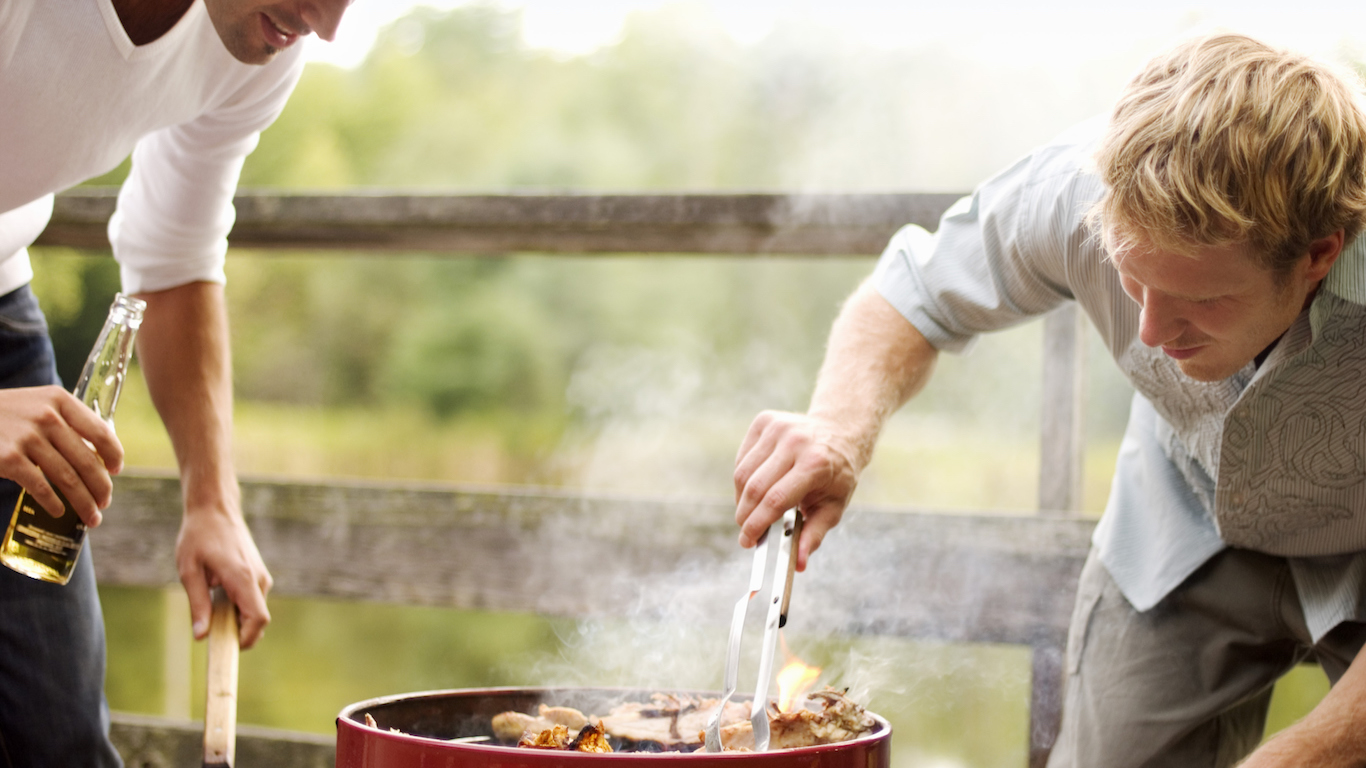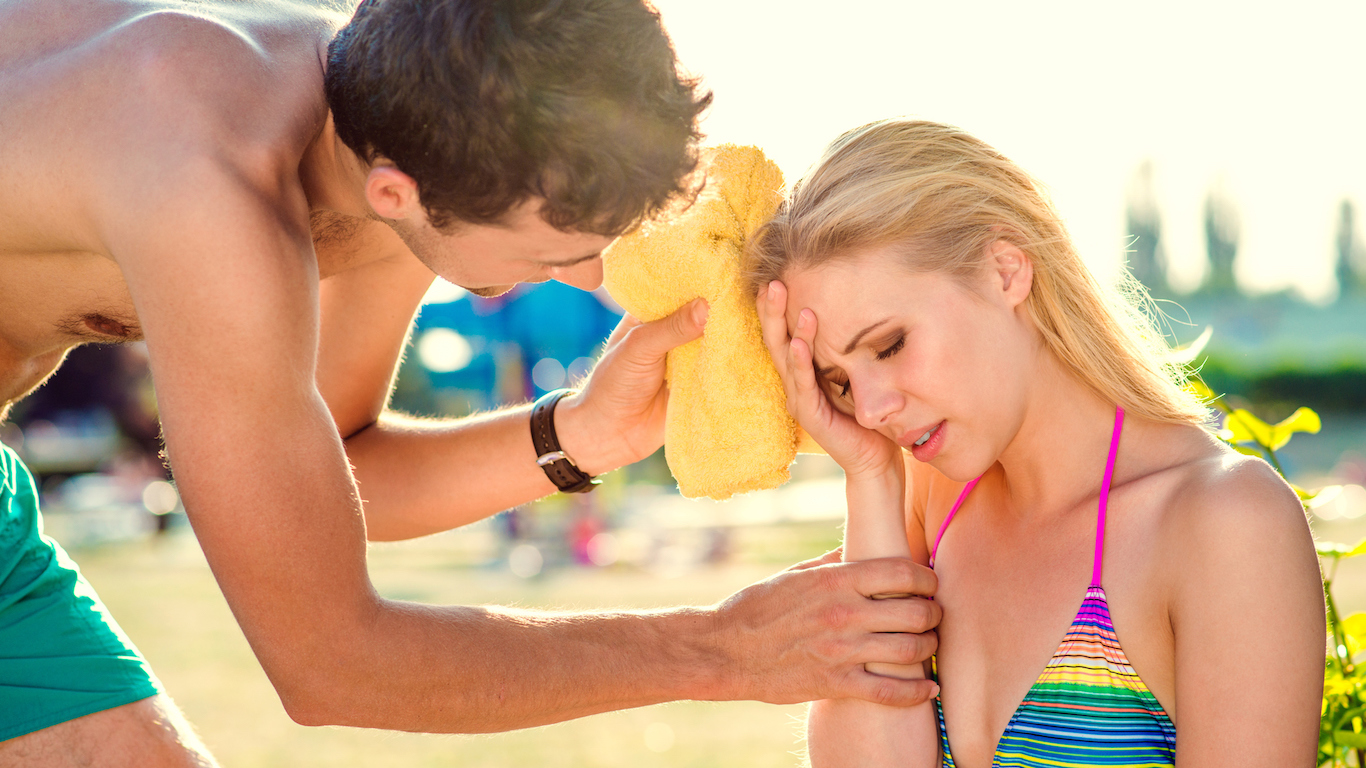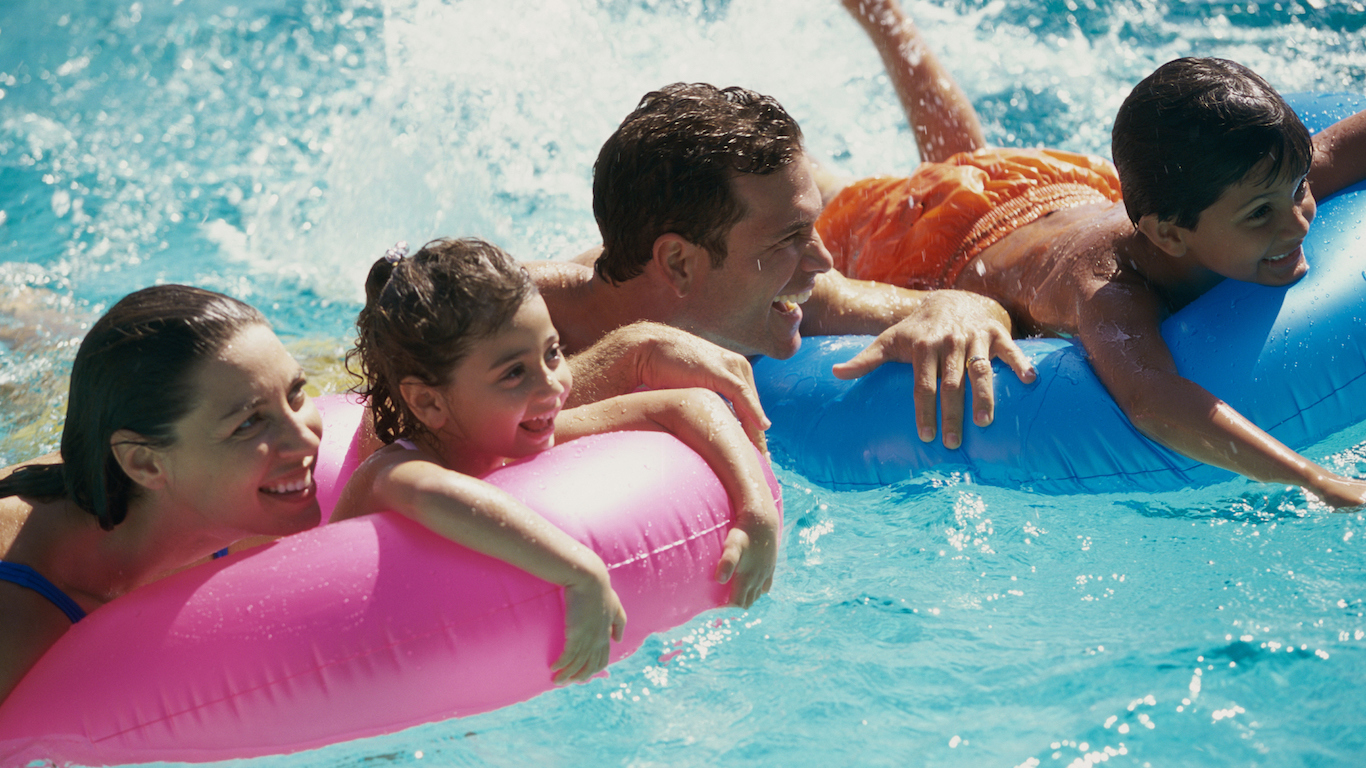Special Report
17 Health Hazards You Want to Avoid This Summer

Published:
Last Updated:

Kids and adults alike crave the sweet summertime. School’s out and family activities are in order, with trips to the beach, water parks, the local swimming pool — you name it. But that beautiful sun that glimmers so elegantly on the water’s surface can be menacing.
Sun and heat-related illnesses are the most prevalent of summer injuries. To give you an idea of how prevalent this issue is, seven out of the 17 health hazards on this list are tied to the sun’s intensity. According to the CDC, 618 people in the U.S. die from extreme heat each year due to lack of hydration and being exposed to the sun for too long.
Other summer hazards include accidents with fireworks, contamination in the water, and even grilling food. Read on to find out what hazards you and your family can dodge this summer, so you can still catch some rays and partake in all of the joys of the season without making a trip to the emergency room.
Methodology:
To identify the most prevalent health hazards you want to avoid this summer, 24/7 Wall St. reviewed several sources including the CDC, National Cancer Institute, USDA, National Fire Protection Association, and Consumer Product Safety Commission.
Click here to see the 17 health hazards to avoid this summer.

1. Carcinogens from Grilling
If you prefer a well-done or even charred patty over one that’s medium-well or rare, you may be increasing your chances of cancer. How? When the amino acids (the building blocks of protein) in meat become heated from grilling over an open flame or pan-frying on top of a stove, a carcinogen called heterocyclic amines (HCA) forms. Another carcinogen, polycyclic aromatic hydrocarbons (PAHs), forms specifically from grilling meat over fire. As fat and juices from the meat fall into the fire, flames with PAHs arise and then cling to the exterior of the meat. Both carcinogens have been found to be mutagenic, which means they can mutate DNA and increase risk of developing cancer. Maybe going for a medium-well burger or steak is the better move after all?
[in-text-ad]

2. Heat Exhaustion
Heat exhaustion, the most common among the various heat-related ailments, occurs when the body loses an excessive amount of water and sodium from profuse sweating. Symptoms include heavy sweating, headache, nausea, thirst, and irritability, as well as a few others. Those at risk are people who have high blood pressure, work in a hot environment, and the elderly. To prevent heat exhaustion from happening try to stay in a cool area, preferably air conditioned, a few hours a day and hydrate plentifully.

3. Drowning
If you’re not having the urge to go to the beach or dive in a pool, is it really summer? This timeless activity not only makes a comeback every year, but rarely do we get tired of cooling off in a body of water. But before you flock to the beach, pool, or lake, keep in mind that one of the leading causes of death for children between 1 and 14 years old is drowning. While injuries aren’t usually the first thing we think of when we enjoy water activities, taking precautionary steps can help lower the odds of all-too-common accidents like drowning. The most important measure to avoid injury is to always be on the lookout. Learn what drowning looks like. Unlike in the movies, you may not hear it happening. Also, teaching your children the basics of swimming not only keeps your mind at ease but creates more opportunities for your kids to have fun. Life jackets or flotation devices are also a good option, even if the kids know how to swim. Why not join in for a swim?

4. Smog
During the summer months, it’s both a joy and treat to roam around outside and breathe in the all of the summer-time scents like freshly cut grass, daisies just as they bloom, and even a whiff of suntan lotion. So go ahead, take that deep breath…or maybe not.
Ozone, which is found in the the upper atmosphere, is harmful to air quality at ground level, according to the Environmental Protection Agency. Ground level ozone (or smog) is created by a chemical reaction between gases — from burning of fossil fuels, lawn mower exhaust, and power plants, just to name a few — and sunlight. The human population, especially in urban areas and on hot summer days with ample amounts of sunshine, gets the beating. While this is great for our moods, the elderly, young children, people who work outdoors, and individuals with lung disease, and asthma, are especially at risk.

5. Lyme Disease
The summer months bring out the hiker in all of us. But every year around 300,000 Americans contract Lyme disease, according to a recent estimate by the CDC. Ticks are abundant in bushy and wooded areas, so when you find yourself in the great outdoors, insect repellent, shoes, long pants, and long sleeves go a long way. If you feel feverish, fatigued or notice a rash the next few days after spending time outdoors it’s best to go get checked out. If left untreated, Lyme disease could spread to your joints, heart, and nervous system. But if you’re not in the northeast or upper Midwest you may not have much to fear. In fact, 95% of confirmed Lyme disease cases were reported in these regions.
[in-text-ad]

6. Lightning Strikes
What’s a better way to enjoy the summer other than being outside? That’s until you hear the thunder rolling, of course. Although the odds of being struck by lighting in any given year is one in 500,000, it’s better to be safe than sorry. The best defense to lighting is to be aware of your surroundings and to move indoors during lightning storms. But even then, avoid taking a shower, washing dishes, talking on corded phones, or using your laptop if it’s plugged into the wall, because lightning can travel through all of these mediums. Check the forecast before taking part in any activities.

7. Foodborne Illnesses
According to the CDC, 1 in 6 Americans contract food poisoning from contaminated foods or beverages each year. Food poisoning hits its peak in the summer months because foodborne bacteria flourish in hot temperatures, specifically between 90°F and 110°F. Also, there’s more food illness in summer because of outdoor cooking. Make sure to keep raw meat cool before thoroughly cooking so you can avoid ingesting unwanted pathogens; separate raw meat from other foods; and, just like mom used to say, “Remember to wash your hands!”

8. Heat Syncope
Ever heard of heat syncope? While not as common as heat exhaustion, this heat-related illness involves fainting and dizziness. Heat syncope occurs after extended periods of standing and can even happen after sitting up too quickly from lying under the sun for a few hours. Dehydration and lack of acclimatization can cause such episodes. It’s best to slowly drink water and opt for a chair in the shade or a cool place if you feel even the slightest bit light-headed.

9. Sunburn
Probably the most common health hazard in the summertime is good ole’ sunburn. While a classic first degree sunburn — red, tender skin — is manageable with the help of aloe vera and anti-inflammatory drugs like ibuprofen, second degree sunburns hurt much more and require more care. Blisters are an indicator of second degree burns. It’s very important that you don’t pop these blisters because, according to the CDC, popping can slow the healing process and increase your chances of contracting an infection. Avoid all of this from happening by slathering on sunscreen periodically while outside, and by staying in the shade or wearing long-sleeve clothes as much as possible.
[in-text-ad]

10. Heat Rash
If you find yourself scratching when it’s hot outside, there’s a chance you may have a heat rash. Although most common with young children, a heat rash can occur at any age, especially if you’re overweight but also if you frequently exercise outdoors. Because a heat rash looks like a cluster of small blisters, it is often hard to identify at first. Be on the lookout for bumps that appear on the neck, chest, groin, and in elbow creases. To prevent it, the CDC suggests to stay in cool areas and to avoid tight clothing which can prevent airflow. If a rash does develop, baby powder may be a good idea to reduce discomfort.

11. Grilling Injuries
So you thought you’d avoid many of the dangers of summer by having a cookout in your backyard, right? Not so fast. In 2014, 16,600 people went to the emergency room from injuries involving the grill. Each year, an average of 8,900 home fires are caused by grilling, with gas grills contributing to a higher number of home fires than charcoal ones. The lead factor contributing to these fires is a failure to clean the grill before use, so be sure to scrub it down before you close it up. But don’t leave metal brush hair on the grill. The stray metal wires can cause major digestive problems.

12. Heat Cramps
Muscle cramps are not ideal in any circumstance and, in most cases, cramping happens as a result of losing sodium, usually from sweating during rigorous physical activity. Sweating is the body’s way of cooling itself, which is a vital bodily function, especially during bouts of extreme heat. However, sweating too much can significantly deplete the body’s supply of sodium — an essential electrolyte that fuels muscle tissue. As a result, the muscles tense and cramp, causing you a whole lot of discomfort. The CDC advises to drink water with a snack or a sports drink every 15-20 minutes to alleviate the cramping.

13. Shark Attack
Should you be worried of dying of a shark attack? No. According to the National Safety Council, the chance of dying of a shark attack is close to one in 3.7 million. Still, there were 47 shark attacks in the United States in 2013. So if a lifeguard tells you to get out of the water, you should listen. Until then, keep on swimming.
[in-text-ad]

14. Rhabdomyolysis
Just because you never heard of rhabdomyolysis — let alone aren’t able to pronounce it — doesn’t mean you should ignore it.
Rhabdomyolysis is a syndrome that can arise after muscle injuries. The condition is associated with overtraining in extreme heat. While this may not seem like an uncommon practice, keep in mind that this medical condition results in the rapid breakdown, rupture, and death of muscle tissues. Simply put, this syndrome can cause irregular heart rhythms, seizures, kidney damage, and even death. While the most common symptom of rhabdomyolysis is dark-colored urine, if you are experiencing muscle cramps, weakness, or an inability to exercise, immediately stop whatever you’re doing and seek prompt care at a nearby medical facility. Until then, drink lots of water and stay in a cool area.

15. Heat Stroke
DANGER. This heat-related ailment is the most serious and fatal of all. Remember that little tidbit on the importance of sweating? To recap, sweating is the body’s way of cooling itself, which is a vital bodily function, especially during bouts of extreme heat. Well, when you suffer a heat stroke, the body loses its ability to cool itself down. The body’s temperature can rise to 106°F or higher in under 15 minutes. With such rapid increase in body temperature, disability or even death can occur if not taken to the hospital immediately. While help is on its way, it’s important to keep the person in a cool place and to attempt to cool the body temperature down with water and ice.

16. Recreational Water Illness
Just when you thought brain-eating amoeba was your biggest concern when going for a dip in warm freshwater — such as lakes, rivers, and hot springs — it turns out there’s something a lot more common that’s worth being mindful of. Recreational Water Illnesses (RWIs) are caused by germs and chemicals we accidentally swallow, have contact with, or breathe in via mist while swimming in a contaminated area. RWIs are much more prevalent and the germs can hang out in close-to-home areas like swimming pools, hot tubs, and water parks.
According to the CDC, the most commonly reported RWI causes diarrhea, but others cause gastrointestinal, skin, ear, eye, respiratory, open-wound, and even neurologic infections. You don’t have to swim in fear this summer, but it’s good to be aware.
[in-text-ad-2]

17. Firework Injuries
Independence day festivities are timeless in the U.S. A day full of cookouts and attending parades with family and friends sets the tone for the event that awaits in the evening — the firework show. But did you know that during the 30 days surrounding The Fourth of July, an average of 250 people pay a visit to the E.R. every day with firework-related injuries?
According to the Consumer Product Safety Commission, sparklers burn at temperatures of about 2,000°F. For perspective, that’s hot enough to melt down some types of metal. So before you allow kids to play with a flaming stick, and before you attempt so yourself, think about the damage it has the potential to cause.
The last few years made people forget how much banks and CD’s can pay. Meanwhile, interest rates have spiked and many can afford to pay you much more, but most are keeping yields low and hoping you won’t notice.
But there is good news. To win qualified customers, some accounts are paying almost 10x the national average! That’s an incredible way to keep your money safe and earn more at the same time. Our top pick for high yield savings accounts includes other benefits as well. You can earn up to 3.80% with a Checking & Savings Account today Sign up and get up to $300 with direct deposit. No account fees. FDIC Insured.
Click here to see how much more you could be earning on your savings today. It takes just a few minutes to open an account to make your money work for you.
Thank you for reading! Have some feedback for us?
Contact the 24/7 Wall St. editorial team.